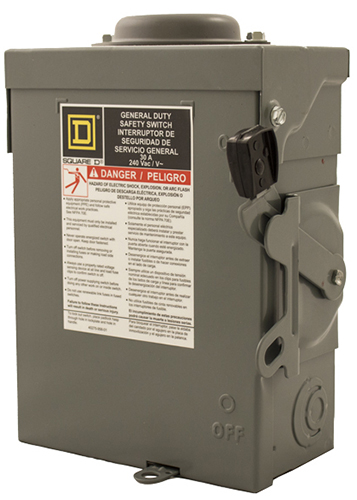 Loading... Please wait...
Loading... Please wait...Products
- Heating and Cooling
- Outdoor Living & Patio
- Solar Kits
- Solar Products
- Solar Panels
- Solar Panel Kits
- Solar Generators
- Inverters
- Inverter Monitoring
- Inverter Accessories
- Balance of Systems
- Racking and Mounting
- Rails
- Flashings
- Splice Kits
- Stopper Sleeves
- Conduit Mounts
- Attachments
- Brace Assembly
- Base Mount
- Brackets
- Bolts
- Clamps
- Caps
- L-Feet
- Washers
- Skirt
- Lugs
- Tilt Legs
- Hooks
- Stand-Offs
- Ballast Bay
- Top of Pole Mount
- Side of Pole Mount
- Flush Mount Kits
- Ground Mount Kits
- Roof Mount Kits
- Hardware Packages
- Wire Management
- Batteries
- Battery Accessories
- Charge Controllers
- Tools and Supplies
- View All Products
Solaris Blog - AC Disconnect
How to Properly Size a Disconnect Box
Posted by Brandi Casey on 21st Apr 2017
In terms of safety, properly sizing and utilizing a disconnect box is among is extremely important to ensure the lifetime of your system. Disconnect boxes are available for both AC and DC connections and can protect your inverter and utility components. Typically, there are two disconnect boxes in any given system, one for the DC connection and one for the AC connection. The DC connection is wired between the source of energy, in this case the solar panels, and your inverter. The DC disconnect is used to interrupt the DC current from the solar panels to the inverter in the event of a power surge. While the AC disconnect is used to separate the inverter from the electrical grid. The DC disconnect is typically installed in an indoor environment, while the AC disconnect is installed in the outdoor environment, close to the electric meter. Both are equally important and are essential components to have for solar permits to be approved under the NEC requirements.
In general, in order to size an AC or DC disconnect you must consider the voltage, circuit load, amps or breaker size and wiring of your equipment, components and connectivity throughout your solar array. According to NEC 690.10 “The circuit conductors between the inverter output and the building or structure disconnecting means shall be sized based on the output rating of the inverter. These conductors shall be protected form over currents in accordance with Article 240. The over current protection shall be located at the output of the inverter.” Perfectly clear? Not so much? Let’s break it down.
Standard Array Sizing Specifications
|
Maximum System Voltage: |
|
|
Range of Operating DC Voltage: |
|
|
Maximum Operating Current (DC): |
|
|
Maximum Array Short Circuit Current (DC): |
|
|
Maximum Utility Back Feed Current (DC): |
|
|
Operating Voltage Range (AC): |
|
|
Operating Frequency Range: |
|
|
Nominal Output Voltage (AC): |
|
|
Nominal Output Frequency: |
|
|
Maximum Continuous Output Current: |
|
|
Power Factor: |
|
|
Maximum Continuous Output Power (AC): |
|
|
Maximum Output Fault Current (AC): |
|
|
Maximum Output Over-Current Protection: |
|
| Efficiency: |
|
|
Total Harmonic Distortion: |
|
Taking standard measurements, lets us say we have a PV array which consists of 20 parallel-connected PV-strings. Each string has 30 series connected solar panels, and each of those panels has a maximum Voc of 28.4 VDC an Isc of 7.95 Amps. The highest inverter power output is calculated at the maximum power point, which occurs at approximately 146 A (IMPP).
The Voc determines the maximum voltage rating of the disconnect switch:
30 x 28.4 V = 852 Volts
Selecting a disconnect switch with a VI and VE of 1000 VDC would give a safety margin greater than 15%
The sum of ISC parallel-connected strings determines the current-capability requirements for the switch. Therefore, the sum of ISC:
20 x 7.92 A = 158 Amps
At a minimum, the NEC requires this value to increase by 125% to address increased current at peak sun hours.
If the ambient temperature is up to 60°C, temperature must be taken into account, for 60°C the factor is 0.80. Applying the factor by dividing the maximum power point current by the factor will show how the disconnect switch should be rated under normal conditions:
146 A / 0.80= 182.5 Amps
To find out more about sizing a disconnect switch, check out this article from Home Power - Solar Electricity Basics
To look at our available disconnect switches, we recommend starting with Square D.




